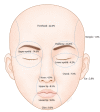Analysis of patients with facial lacerations repaired in the emergency room of a provincial hospital
- PMID: 25606487
- PMCID: PMC4297803
- DOI: 10.5999/aps.2015.42.1.34
Analysis of patients with facial lacerations repaired in the emergency room of a provincial hospital
Abstract
Background: Facial laceration is the most common injury encountered in the emergency room in the plastic surgery field, and optimal treatment is important. However, few authors have investigated this injury in all age groups or performed follow-up visit after repair. In the present study, the medical records of patients with lacerations in the facial area and underwent primary repair in an emergency room over a 2-year period were reviewed and analyzed.
Methods: Medical records of 3,234 patients with lacerations in facial area and underwent primary repair in an emergency room between March 2011 and February 2013 were reviewed and identified.
Results: All the 3,234 patients were evaluated, whose ratio of men to women was 2.65 to 1. The forehead was the most common region affected and a slip down was the most common mechanism of injury. In terms of monthly distribution, May had the highest percentage. 1,566 patients received follow-up managements, and 58 patients experienced complications. The average days of follow-up were 9.8.
Conclusions: Proportion of male adolescents was significantly higher than in the other groups. Facial lacerations exhibit a 'T-shaped' facial distribution centered about the forehead. Careful management is necessary if a laceration involves or is located in the oral cavity. We were unable to long term follow-up most patients. Thus, it is necessary to encourage patients and give them proper education for follow-up in enough period.
Keywords: Facial injuries; Follow-up studies; Lacerations.
Conflict of interest statement
No potential conflict of interest relevant to this article was reported.
Figures






Similar articles
-
A clinical study of emergency room visits for oral and maxillofacial lacerations.J Korean Assoc Oral Maxillofac Surg. 2015 Oct;41(5):246-50. doi: 10.5125/jkaoms.2015.41.5.246. Epub 2015 Oct 20. J Korean Assoc Oral Maxillofac Surg. 2015. PMID: 26568926 Free PMC article.
-
Clinical characteristics and treatment of blow-out fracture accompanied by canalicular laceration.J Craniofac Surg. 2012 Sep;23(5):1399-403. doi: 10.1097/SCS.0b013e31825ab043. J Craniofac Surg. 2012. PMID: 22948636
-
Nitrous oxide administered by the plastic surgeon for repair of facial lacerations in children in the emergency room.Plast Reconstr Surg. 2006 Apr 15;117(5):1571-5. doi: 10.1097/01.prs.0000206298.71083.df. Plast Reconstr Surg. 2006. PMID: 16641727 Clinical Trial.
-
[Treatment of traumatic facial injuries].Ugeskr Laeger. 2014 Sep 22;176(39):V05140308. Ugeskr Laeger. 2014. PMID: 25294326 Review. Danish.
-
Advanced laceration management.Emerg Med Clin North Am. 2007 Feb;25(1):83-99. doi: 10.1016/j.emc.2006.11.001. Emerg Med Clin North Am. 2007. PMID: 17400074 Review.
Cited by
-
Updates in emergency department laceration management.Clin Exp Emerg Med. 2019 Jun;6(2):97-105. doi: 10.15441/ceem.18.018. Epub 2019 Apr 8. Clin Exp Emerg Med. 2019. PMID: 30947489 Free PMC article.
-
Pattern of Facial Laceration at Tertiary Care Centre in Eastern Nepal: A Descriptive Cross-sectional Study.JNMA J Nepal Med Assoc. 2024 Mar 31;62(272):238-241. doi: 10.31729/jnma.8537. JNMA J Nepal Med Assoc. 2024. PMID: 39356846 Free PMC article.
-
Time to wound closure in facial soft tissue injuries following road traffic accidents.Int Wound J. 2024 Jun;21(6):e14910. doi: 10.1111/iwj.14910. Int Wound J. 2024. PMID: 38826063 Free PMC article.
-
Tailored versus conventional surgical debridement in complex facial lacerations in emergency department: A retrospective study.Medicine (Baltimore). 2023 Apr 25;102(17):e33572. doi: 10.1097/MD.0000000000033572. Medicine (Baltimore). 2023. PMID: 37115088 Free PMC article.
-
Analysis and management of pathogens isolated from patients with complicated facial lacerations and abrasions.Int Wound J. 2023 Jan;20(1):85-91. doi: 10.1111/iwj.13842. Epub 2022 May 30. Int Wound J. 2023. PMID: 35637544 Free PMC article.
References
-
- Key SJ, Thomas DW, Shepherd JP. The management of soft tissue facial wounds. Br J Oral Maxillofac Surg. 1995;33:76–85. - PubMed
-
- Lee RH, Gamble WB, Mayer MH, et al. Patterns of facial laceration from blunt trauma. Plast Reconstr Surg. 1997;99:1544–1554. - PubMed
-
- Kim YW, An SH, Ryu SY, et al. Clinical evaluation of facial laceration patients who visited Tertiary Emergency Medical Center. J Korean Soc Emerg Med. 2001;12:143–151.
-
- Jung YH, Hwang MK, Hwang SM, et al. Clinical analysis of pediatric facial laceration. J Korean Soc Plast Reconstr Surg. 2011;38:761–764.
-
- Baker MD, Selbst SM, Lanuti M. Lacerations in urban children. A prospective 12-January study. Am J Dis Child. 1990;144:87–92. - PubMed
LinkOut - more resources
Full Text Sources
Other Literature Sources

